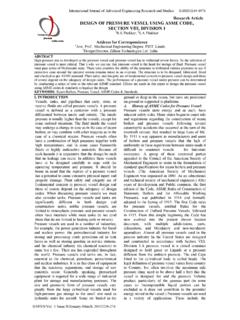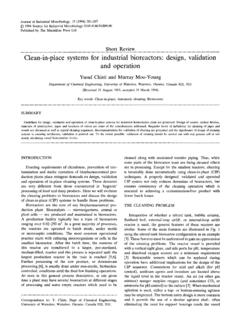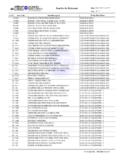Transcription of The Truth about the SL-1 Accident Understanding …
1 1 The Truth about the SL-1 Accident Understanding the Reactor Excursion and Safety Problems at SL-1 On the night of January 3, 1961, the SL-1 nuclear reactor, a prototype for a military installation to be used in remote Arctic locations, exploded, killing the three member military crew. The crew had been performing the routine process of re-assembling the reactor control rod drive mechanisms during a reactor outage. The SL-1 was a small 3 Mega-Watt-thermal (MWt) boiling water reactor, complete with a turbine-generator and condenser designed to generate both electric power and building heat. 1 The SL-1 was designed, constructed and initially operated by Argonne National Laboratory. It was located at the Idaho National Laboratory, then called the National Reactor Testing Station. Combustion Engineering became the operating contractor for the Atomic Energy Commission (now the Department of Energy) for SL-1 on February 5, 1959.
2 The crew that night were young military men in their twenties, all with families. There were three 8-hr shifts working around the clock. Combustion Engineering s request for funding to provide staffing to supervise more than the 8-hr day shift had been denied by the AEC, the agency that was predecessor to the Department of Energy. The three-man crew on the evening shift had a large number of tasks to perform on the operating room floor and there was no one in the control room to keep logs books, monitor plant conditions, or inform emergency responders of plant radiation status or the whereabouts of the crew. The SL-1 core contained 14 kg of 93 percent enriched Uranium-235 in 40 aluminum fuel assemblies. Control of the reactor used 5 cruciform-shaped cadmium control blades raised and lowered by control rods. There were 4 outer (shim) control rods, labeled No.
3 1, 3, 5 and 7, and one center control rod, No. 9, to regulate reactor power. In addition to the control rods, burnable poison was added in the form of aluminum-boron strips, both half length and fuel length, that were spot welded to the sides of the fuel assemblies. See Figure 1. The SL-1 had first gone critical on August 1, 1958 and by July 1, 1959 had accumulated 160 Mega-Watt operating days (MWD). By August 21, 1960, the reactor had accumulated 1 Various DOE reports released by Freedom of Information Act request about SL-1 are at Key Things to Remember about What Caused The SL-1 Accident : 1. Poor design of the reactor provided significant vulnerability to over-withdrawal of the center control rod during power operation and shutdown maintenance due to its excessive reactivity worth.
4 2. Radiation-induced damage to reactor materials was causing swelling and deformation in core materials at an increasing rate during the last month of operation. 3. The SL-1 s history of frequent control rod sticking was downplayed and ruled out as a cause of the Accident long before the damaged core was closely examined. Possible reasons for reduced clearances or caught-edges at the height the rod was at when the over-lifting occurred were not explored. Numerous weld and material discontinuities exist in the area of the rod and shroud interface where the rod was being lifted up into the shroud that could have hindered free movement of the rod. 4. The extra effort required to jerk free the 84-lb stuck rod could easily have resulted in the roughly 16 inches of over-travel to achieve the 20 inch withdrawal from normal scram position and in less than a third of a second.
5 2 680 MWD. The boron strips were deteriorating and bowing of the strips made removal of fuel assemblies difficult; therefore, fuel inspections simply ceased. 2 The routine maintenance procedure for the SL-1 to re-connect control rod drives after work above the core, such as installing flux monitoring wires, required manually lifting, twice, each of the 84 lb rods, that included the cadmium control blades, connecting and extension rods and upper-most portion called the rack. Fire alarms activated automatically from heat detectors in the building, signaling fireman and other emergency responders to drive several miles to the Army Reactor Experimental area. There had been two false alarms earlier in the day that had required firemen to drive to SL-1, but the 9:01 pm alarm would bring responders into any but a routine situation.
6 And the fire alarms could not be distinguished from radiation alarms. The center control rod would later be found withdrawn 20 inches relative to the normal scram position. 3 Numerous accounts would say it was greater than this distance, including the Department of Energy s Proving the Principle which incorrectly states it was manually withdrawn 26 inches. 4 Of the 20 inches it was withdrawn inside the core, it was initially already withdrawn by at least 2 inches and probably by 3 inches. 5 The operator needed only to bend down, clasp the vertical shaft and ease the 84 lb rod up an additional inch or two, wait for his co-worker to remove the C-clamp, and then lower the rod back down. 2 Atomic Energy Commission report, Idaho Field Office IDO-19300, SL-1 Reactor Accident on January 3, 1961: Interim Report.
7 Combustion Engineering, May 15, 1961. 3 Atomic Energy Commission report, Idaho Field Office, IDO-19311, Final Report of the SL-1 Recovery Operation, General Electric Co., June 27, 1962. partial center rod withdrawal of 20 inches, p. 146. 4 Susan Stacy, Proving the Principle A History of the Idaho National Engineering and Environmental laboratory, 1949-1999, Washington, : US Department of Energy. p. 148. and 5 ibid. IDO-19311, p. III-109] Figure 1. SL-1 Reactor perspective from IDO-19311. 3 While the mechanism for the severe explosion was not immediately apparent, it was found that the center control rod (No. 9) had been lifted too high high enough for the reactor to cause a steam explosion from the prompt critical rapid generation of neutrons that heated the reactor fuel, vaporized some of the fuel and flashed the water in the reactor vessel to steam.
8 A new core and rod drive mechanism was scheduled to be installed in the spring of The new rod drive mechanism would have eliminated the need to manually raise a control rod during the coupling operation. Later examination of the core internals would also identify numerous pre- Accident weld, corrosion, and material issues in the damaged core. 7 The Rod Withdrawal Distance for Prompt Criticality Was Unknown After the Accident , reports would state that a reactivity addition of percent delta k/k had put the reactor on a 4 millisecond period. While sounding innocent enough, the reactor design allowed manual movement of a single control rod to insert a huge amount of reactivity change rapidly enough to cause the Accident . Prior to the Accident , no one had computed the prompt criticality rod withdrawal distance.
9 The 4 millisecond neutron population doubling would mean such a rapid increase in neutrons that the heat generated in the fuel could not be transferred to the coolant water before some of the plates would vaporize from the high temperatures. The complex and irregular arrangement of burnable boron strips made modeling the SL-1 core particularly difficult. Before the Accident , the calculations for predicting normal criticality for reactor operation and the corresponding control rod withdrawal positions for achieving criticality were based on greatly over-simplified computations because of the difficulty in analyzing the complex non-symmetrical geometry of the core. In fact, even studies attempted today find the complex arrangement untenable. The simplified analysis had deviated significantly from the actual observed reactor core control rod positions needed for reaching criticality for normal power operation.
10 8 Reactivity shutdown margin is known to change over time with reactor burnup. Very little monitoring to compare predicted to actual reactivity shutdown margins was performed at SL-1. As a prototype, its unproven design should have resulted in more, not less attention than is ordinarily performed at reactor facilities. Such monitoring was hindered by lack of staff and inaccuracies in recorded conditions including errors in accurately zeroing the control rod drives. Post- Accident calculations would require tedious and imprecise delving into operating records to try to account for the previous month s operation. 9 Reactivity shutdown margin and the reactivity worth of each rod are affected by core geometry, individual fuel element history, water temperature, Xenon decay and in the SL-1, also by the 6 ibid.





